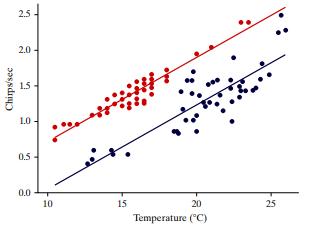Temperature affects the rate at which a cricket chirps; the higher the temperature, the faster the rate.
Question:
Temperature affects the rate at which a cricket chirps; the higher the temperature, the faster the rate. A South African researcher collected data (chirp rate in chirps per second and air temperature in degrees Celcius) for some African crickets. The results, shown in the following scatterplot, have a regression equation of chirps per second = 0.1654 + 0.0646(temperature) and a correlation of 0.618.

a. What does the slope of the regression equation mean in context?
b. What is the value of R2, and what does that number mean in context?
c. There were two different species of crickets represented in the data. In the following scatterplot, the blue dots represent the Karschi species, and the orange dots represent the Fultoni species. The regression equations are given in (i).
i. Which equation, A or B, represents the Fultoni crickets? Explain how you know.
A. chirps per second = −1.1318 + 0.1181(temperature)
B. chirps per second = −0.4545 + 0.1175(temperature)
ii. How has the value of R2 changed from when all the crickets were included to including just the Fultoni species? To including just the Karschi species?

Step by Step Answer:

Introduction To Statistical Investigations
ISBN: 9781119683452
2nd Edition
Authors: Beth L.Chance, George W.Cobb, Allan J.Rossman Nathan Tintle, Todd Swanson Soma Roy





